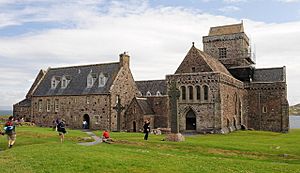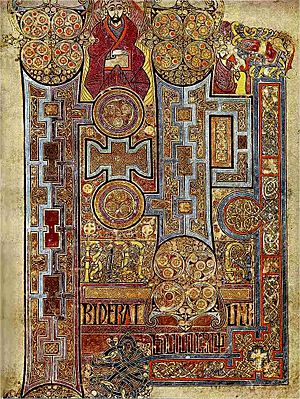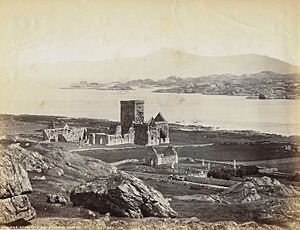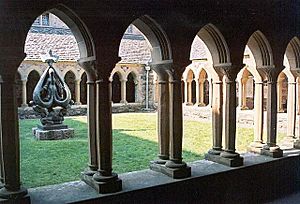Iona Abbey facts for kids
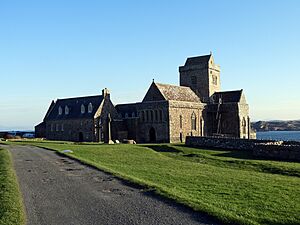 |
|
| Lua error in Module:Location_map at line 420: attempt to index field 'wikibase' (a nil value). | |
| Established | 563 |
|---|---|
| Location | Isle of Iona PA76 6SQ, United Kingdom |
Iona Abbey is an important religious building. It is located on the Isle of Iona, which is a small island near the Isle of Mull on the west coast of Scotland.
This abbey is one of the oldest Christian religious places in Western Europe. It was very important for spreading Christianity across Scotland. The abbey was started by Saint Columba in 563 AD. At that time, Iona was part of a kingdom called Dál Riata. Saint Aidan, a monk from Iona, later helped bring Christianity back to Northumberland in England.
Later, in the 12th century, the Macdonald lords of Clan Donald made Iona their main religious center. They supported and looked after the abbey, church, and a nunnery. Two Macdonalds even became Bishops of the Isles, with their main church at Iona. St. Oran's chapel was where these lords were buried.
From 1207 to 1493, the Clan Donald and their Lords of the Isles were very important to Iona Abbey. They helped it grow and become famous. The abbey church you see today was mostly built in the 15th century by these Macdonald Lords.
Today, Iona Abbey is the spiritual home of the Iona Community. This is a Christian group that welcomes people from different churches. Their main office is in Glasgow. The Abbey is still a popular place for Christian visitors today.
Contents
History of Iona Abbey
How Iona Abbey Began
In 563 AD, Saint Columba came to Iona from Ireland. He brought twelve friends with him. Together, they started a monastery there. A monastery is a place where monks live and worship. This monastery became a very important place for spreading Christianity among the Picts and Scots.
At first, the island and abbey were called "Hy" or "Hii." The name "Iona" only started to be used around the 14th century. It came from a mistake when writing the Latin name "Ioua."
Life at the Monastery
The main goal of the monastery was to be a "perfect monastery." Saint Columba wanted it to be an example of Christian virtues for everyone. The monks prayed and worked every day. They followed the practices of Celtic Christianity. They also managed the monastery's resources and helped the local community.
Building the First Monastery
Like other early Christian monasteries, Columba's monastery was likely made of wood and thatch. It would have had a main church or prayer room. There was also a kitchen, a library, and sleeping areas for the monks. A guest house was available for visitors and pilgrims. It is thought that around 800 AD, the first wooden chapel was replaced with one made of stone.
The monastery was surrounded by a ditch and an earth wall. Some parts of this wall might have been there before Columba arrived. You can still see some of it to the northwest of the current abbey buildings.
Columba's Special Room
A writer named Adomnán described a building on a small hill called Torr an Aba. This was where Saint Columba worked and wrote. Scientists have found burnt wood from what they believe was this spot. There is also a place where a cross was later put up.
Making Books and Manuscripts
Creating Christian manuscripts and books was a key activity at Iona. The Chronicle of Ireland included records made on Iona until about 740 AD. The famous Book of Kells is believed to have been made by the monks of Iona around 800 AD. This book is an illuminated manuscript, meaning it has beautiful drawings and decorations.
Stone Crosses at Iona
Stone crosses were used to mark graves at the monastery. Large stone crosses were also put up. These might have been used to share important Christian messages. They were often built between 800 and 1000 AD. Their designs looked like crosses made from precious metals. Some were carved from stone brought by boat from Loch Sween, about 50 miles (80 kilometers) away.
Viking Attacks and Changes
Vikings first attacked Iona Abbey in 795 AD. More attacks happened in 802, 806, and 825 AD. During the 806 attack, 68 monks were killed in a place now called Martyrs' Bay. Because of these dangers, many monks moved to a new monastery in Kells, Ireland.
The building at Kells was finished in 814 AD. In that year, Cellach, the Abbot of Iona, moved to Kells. However, Iona remained an important center for the monks for many years. In 825, Saint Blathmac and other monks who stayed at Iona were killed in another Viking raid. The Abbey was also burned.
In 878, the main holy items of Saint Columba were moved to Ireland. Kells then became the main home for the monks. It is thought that the Book of Kells might have moved to Kells at this time too. Even so, Iona Abbey was probably not empty. Its importance continued, as shown by the death of Amlaíb Cuarán, a retired King of Dublin, there in 980 AD.
Saint Columba started several monasteries in Britain and Ireland. But Iona was his main base. Some monks from Iona also moved to Europe. They started monasteries in Belgium, France, and Switzerland.
The Benedictine Abbey Era
In 1114, the King of Norway took control of Iona. He held it for 50 years. Then, Somerled took it back. In 1164, he invited Irish monks to return. This led to the building of the central part of the cathedral. In 1203, Ranald, Somerled's son, invited the Benedictine order to start a new monastery. He also invited the Augustinian order to start a nunnery. These were built on the foundations of Columba's original monastery.
Building work began on the new abbey church. But in 1204, Irish bishops raided the site. They were upset because they were losing their connection to this important place.
The Iona Nunnery was started by Somerled's daughter, Bethóc. It was for Augustinian nuns. This was one of only three such nunneries in Scotland. Graves of some early nuns are still there. One is for Anna Maclean, a remarkable prioress who died in 1543. You can see her rochet, a special pleated garment, under her outer robe. This shows she was an Augustinian nun. The nunnery buildings were rebuilt in the 1400s. They fell apart after the Scottish Reformation, a time when many religious changes happened in Scotland.
The abbey church was greatly expanded in the 15th century. The Macdonald Lords of the Isles saw it as their spiritual home. They considered the church their "Cathedral of the Isles." After the Scottish Reformation, Iona Abbey was taken apart and left empty. Its monks and libraries were scattered.
The Modern Abbey
In 1899, the Duke of Argyll gave the ruined abbey and nunnery to the Iona Cathedral Trust. This group began to restore the Abbey church. In 1938, Reverend George MacLeod was inspired to rebuild the abbey. He started the Iona Community. The architect Ian Gordon Lindsay organized the rebuilding. The buildings around the abbey were also rebuilt by the Iona Community during the 20th century. This Christian community, which welcomes people from different churches, still uses the site today.
A simple square font was added in 1908. It was dedicated to the memory of Reverend Theodore Marshall.
In 2000, the Iona Cathedral Trust gave the care of the Abbey, Nunnery, and other sites to Historic Scotland. This is a government agency that looks after historic places.
In June 2021, the abbey reopened after a big renovation. This project cost £3.75 million. The Iona Community raised the money over three years. The renovation included a new renewable energy system and fast internet.
Interesting Features at Iona Abbey
Many early Scottish kings are said to be buried in the Abbey graveyard. Some stories say 48 kings were buried there. Kings from Ireland, Norway, and France are also mentioned. However, modern experts are not sure if these claims are true. They might have been stories to make Iona seem more important. Many important people from the Hebrides, like the Lords of the Isles and leaders of Scottish clans, were buried on Iona. This includes several Maclean and MacLeod chiefs. John Smith, a leader of the Labour Party in the 20th century, loved Iona. He was buried there after his death in 1994.
Several tall stone crosses are found on Iona. St Martin's Cross, from the 8th century, still stands by the road. A copy of St John's Cross is by the Abbey doorway. The original St John's Cross is in the Infirmary Museum behind the abbey.
The sculptor Christopher Hall worked for many years on carvings in the abbey's cloisters. These carvings show birds, plants, and animals found on the island. He also carved John Smith's gravestone.
Interesting Facts About Iona Abbey
Many early Scottish kings are said to be buried in the Abbey graveyard. Some stories say 48 kings in total, from Scotland, Ireland, Norway, and France, are buried there. However, modern experts are not sure if these stories are true. They were probably told to make Iona seem more important. Many important people from the Hebrides, like the Lord of the Isles and leaders of other Scottish clans, were buried on Iona. This includes several Maclean and MacLeod chiefs. John Smith, a leader of the Labour Party in the 20th century, loved Iona. He was buried there after he died in 1994.
Several tall high crosses are found on Iona. St. Martin's Cross, which is from the 8th century, still stands by the road. A copy of St. John's Cross is by the abbey doorway. The real St. John's Cross is in the Infirmary Museum behind the abbey.
A sculptor named Christopher Hall worked for many years on the carvings in the abbey's cloisters. These carvings show birds, plants, and animals that live on the island. He also carved John Smith's gravestone.
Images for kids
See also
 In Spanish: Abadía de Iona para niños
In Spanish: Abadía de Iona para niños


